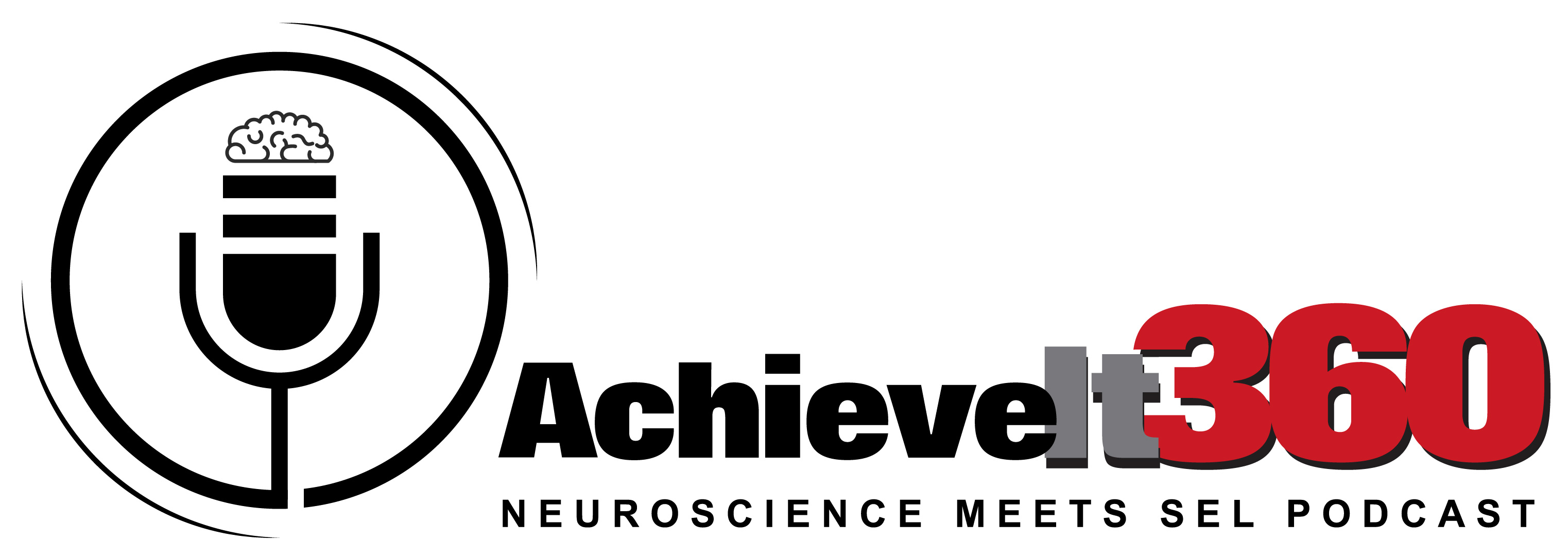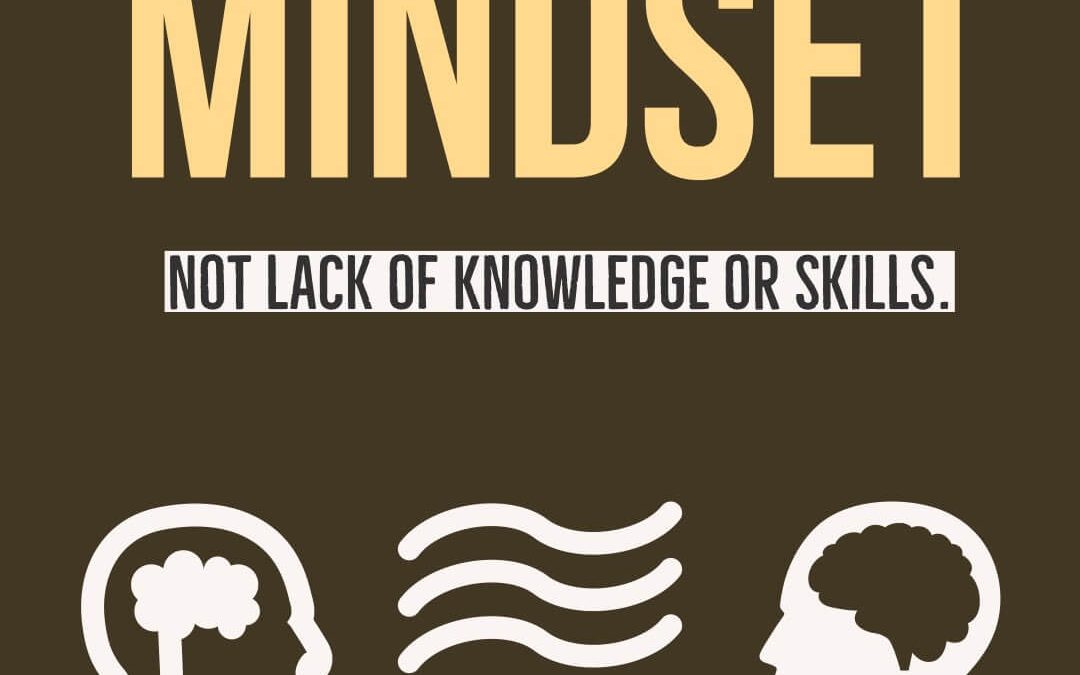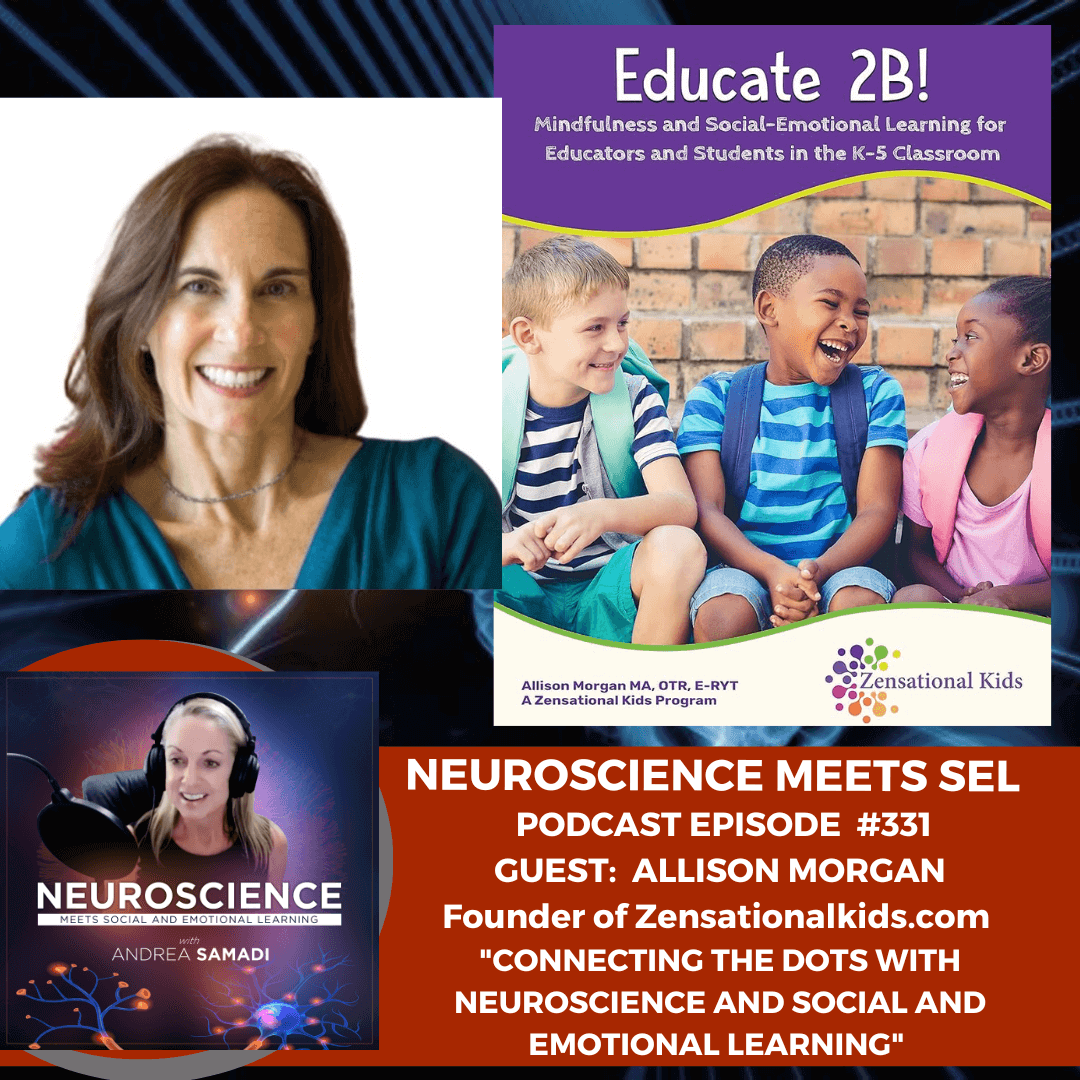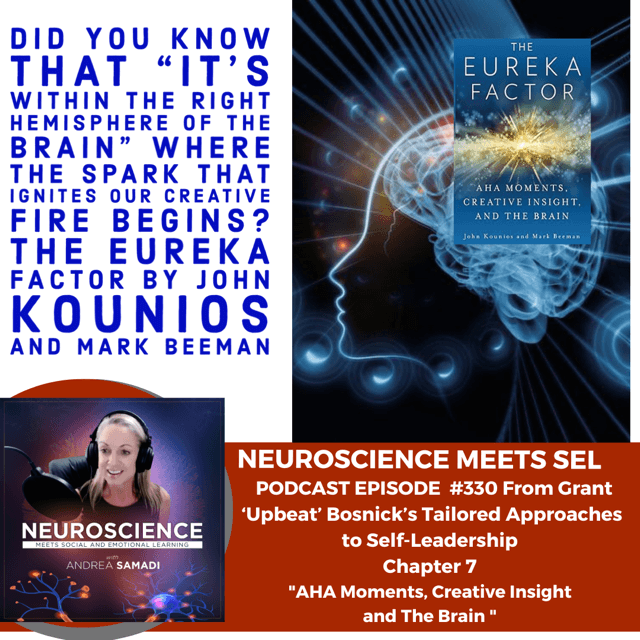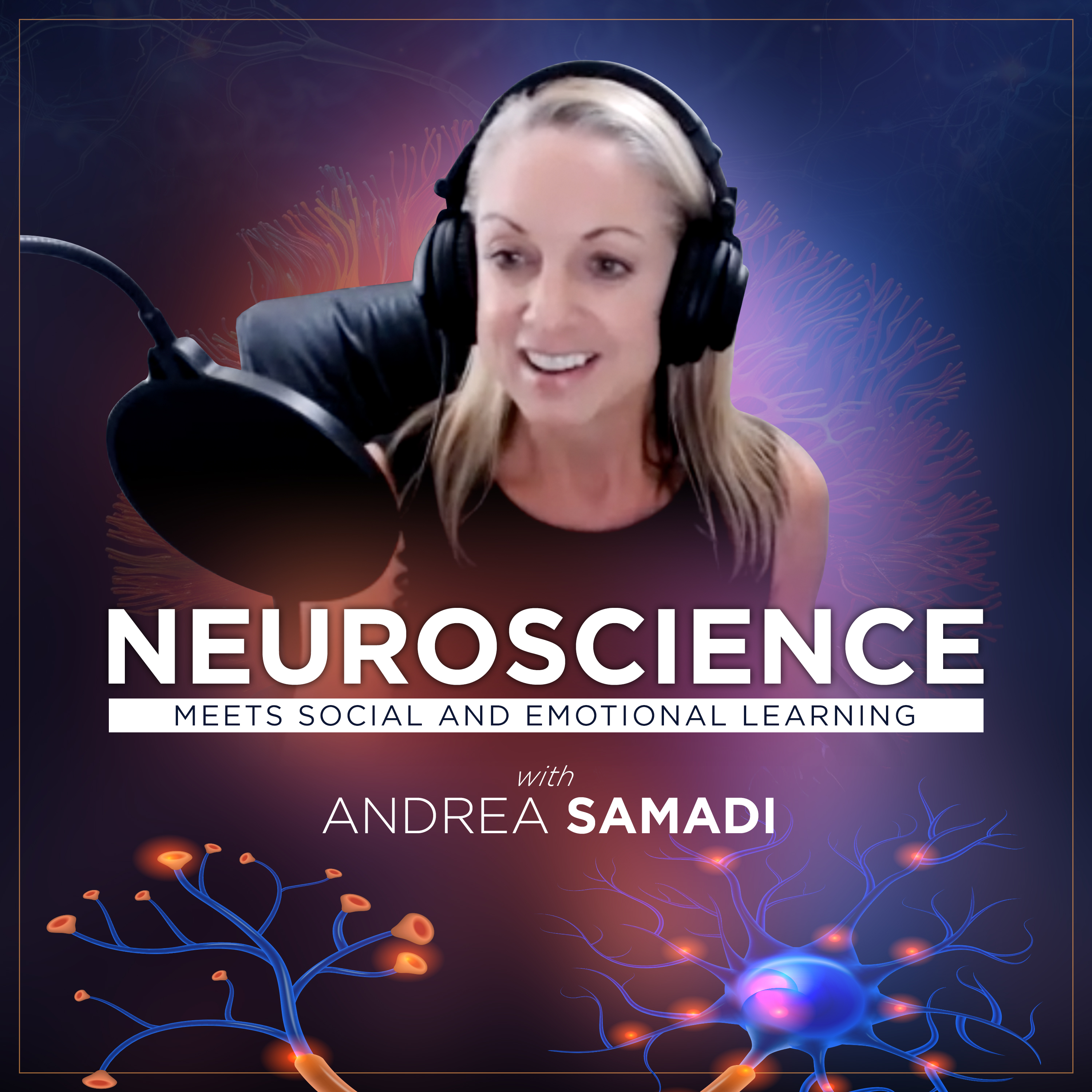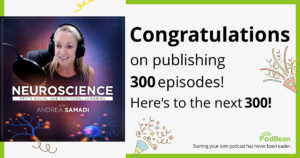Welcome back to the “Neuroscience Meets SEL Podcast” EPISODE 20 this is Andrea Samadi. I want to thank everyone who has been tuning into these episodes. In just a few short months of launching, we have reached 20 countries and the feedback has been incredible. Not only am I hearing that the topics are relevant and applicable, but the need is very clear to continue to interview new leaders in this field of social and emotional learning/emotional intelligence and neuroscience and continue to offer ideas and strategies that can be implemented immediately. If you do have feedback or want to reach me directly, you can find me (Andrea Samadi) on LinkedIn or Twitter or send me an email to andrea@achieveit360.com
Our initial goal with this podcast was to close the gap recent surveys show exists in our workforce where 58 percent of employers say college graduates aren’t adequately prepared for today’s workforce, and those employers noted a particular gap in social and emotional skills. Research shows that social-emotional skills like social awareness, self-regulation, and growth mindset (the skills that we have been covering in the past episodes) are crucial to college and career readiness. The outcomes of developing these intelligences are vast as they impact our performance, leadership, personal excellence, time management, and decision-making.
As we have progressed, these episodes are bringing together leaders and practitioners in the field who have programs, products, books, and ideas to share, with an urgent need to get this message out to impact our schools, communities, and workplaces. As Clark McKown, the President of xSEL Labs, SEL Assessment mentioned in our podcast interview EPISODE 10, “it’s important that we bring people to have conversations (around SEL/emotional intelligence) to propel us forward—bringing the different strands of the SEL movement together—and having them coordinate is going to be (the) key. There’s potential for a whole that’s greater than the sum of its parts.”[i] I hope that you agree with me how important this work is, and if you are finding these episodes helpful, please do share them on your social media so that others can gain access.
So far, we’ve covered five of the six social and emotional learning competencies to dive deep into and tie in how an understanding of our brain can facilitate these strategies. The sixth social and emotional competency, Mindset, fits in to the Social and Emotional Track with the ability to understand your own emotions (when you feel like something might be difficult and you become frustrated and ready to give up) as well as the Cognitive Track, using the executive functions of our brain—with the needed ability to persevere, problem solve, and come up with a different strategy.
With each competency, we investigate the best practices that you can use to develop and improve your own SEL/Emotional Intelligence and well-being practice, before extending these strategies to your districts, schools, classrooms, workplaces and communities. We must first of all practice the concept ourselves, before we teach others because if we haven’t developed a practice ourselves, our students will pick up on the lack of authenticity and won’t take the concept seriously either. The interviews are designed so that you can hear directly from experts in the field who are using these skills on a daily basis. We want the ideas you take away with you to be actionable whether you are an educator working in a school, an employee or manager in a corporation, or someone just looking to take their skills to the next level. Be sure to look for the resources in the show notes section if you would like to dive deeper into this topic.
Moving onto the topic of “Mindset” it’s important to notice that ten years after Carol Dweck’s essential finding that for “children who have a “growth mindset” their intelligence can be developed (and students) are better able to overcome academic stumbling blocks than those who have a “fixed mindset” (who think) that intelligence is predetermined (or they must be born with a certain set of skills that can’t be changed)— (these findings are) as relevant as ever.”[ii] Dweck’s work has reached thousands of schools, students and teachers, around the world and her research has been recognized and honored as she was the recipient of the $3.8 million Yidan Prize, the world’s largest international prize in educational research and development.
Applying growth mindset has proven to be something that has not been simple or easy to do—whether in the classroom, workplace, or even in the field of athletics. In the next few sections we will look at the obstacles behind the application of growth mindset in each of these three fields with some suggested strategies for a successful implementation. John Hattie, Professor and Deputy Dean of the Melbourne Graduate School of Education, answers the key question of “WHEN is the appropriate situation for thinking in a growth manner over a fixed manner?“[iii] In the following situations, having access to growth thinking helps resolve the situation, move the person forward, and not lead to resistance, over reaction and fear of flight into a fixed mindset. The major situations for growth mindset are:
- When we do not know an answerWhen we make errorWhen we experience failure orWhen we are anxious.
In each of these situations, having a strategy to help us to pivot, try a new angle, so we can learn from what did not work last time, will help access those breakthroughs, and those Aha! Moments of learning that can only occur when we persist and persevere instead of giving up. Our end goal is to work towards changing our belief in ourselves, giving us confidence and hope, that comes with time, effort and with each new experience where we overcome a struggle.
Let’s Examine the Obstacles Behind the Application of Growth Mindset in the Classroom:
An Education Week survey found that “the vast majority of educators believe that a growth-oriented mindset can help improve students’ motivation, commitment and engagement in learning. But the study found that applying those ideas to practice, and helping students shift their mindset around learning, remains an elusive challenge.”[iv]
Key Findings from the Education Week Survey[v] showed:
∙ Educators believe growth mindset has great potential for teaching and learning. Nearly all teachers (98%) agree that using growth mindset in the classroom will lead to improved student learning.
∙ Teachers see a strong link between a growth mindset and a range of positive student outcomes and behaviors. More than 90 percent believe growth mindset is associated with excitement about learning, persistence, high levels of effort, and participation in class.
∙ Practices thought to foster a growth mindset are consistently used in the classroom. The majority of teachers report praising students for their effort on a daily basis or encouraging them to continue improving in areas of strength or to try new strategies when they are struggling.
∙ However, putting growth mindset into practice poses significant challenges. Only 20 percent of teachers strongly believe they are good at fostering a growth mindset in their own students. They have even less confidence in their fellow teachers and school administrators. And just one in five say they have deeply integrated growth mindset into their teaching practice.
So, what’s happening to yield such a gap with theory and practice?
Carol Dweck has expressed “concern that teachers are placing emphasis merely on students’ efforts instead of their learning strategies”[vi] and wants to remind us that the real purpose behind growth mindset was to boost student’s learning. All of the effort in the world will not yield results if it’s the wrong strategy for the student.
Three Strategies That Build Growth Mindset in the Light of These Obstacles
-
- Have students try different learning strategies for different subject areas. While preparing a book report, “one student may find a graphic organizer to be a helpful tool for citing evidence, while another prefers to highlight supporting points in different colors. Another might list every possible option for evidence and cross out the weakest ones.”
-
- They may have an entirely different strategy for studying for a science test that would involve mnemonics and memorization, and rote practice of math problems for a math test. Whatever method they choose to use, they will need to monitor and observe how this strategy is working for them and make adjustments when needed.Be sure that teachers are not labelling students “as difficult to teach based on their perceived mindsets.”
-
- It might be easier to suggest that a student has a “fixed mindset” rather than identify a learning challenge with a student. Be sure that all options are explored for each student with the proper interventions put in place.Be careful of a “false” growth mindset. We all want to believe that we have a growth mindset all of the time, but the truth is, that we all go back and forth, depending on what we are doing, and the different circumstances in our lives. Dweck herself notes “we are all a mixture of growth and fixed and need to understand both in ourselves. (She) particularly notes the reactions we have when we face challenges, are overly anxious, in fight or flight.
- Self-awareness comes into play here as we learn to identify the skills in our life that we have a desire to change, and perhaps the ones that we are happy with where they are.
What About Obstacles Behind the Application of Growth Mindset in Athletics
The Rover Soccer Training Academy, one of the top teams in the UK Soccer League, whose Director of Team Performance, Tony Faulkner, came to visit Carol Dweck to find some answers to the problem he was having with some of their players not reaching their highest potential. The problem existed because the British culture held the belief that “soccer stars are born, not made” and if you believe this, and have incredible talent, then the belief would impede this player from seeing the point of daily practice to improve their craft.
Before we can see the benefits that having a Growth Mindset yields, we have to hold the belief that we can in fact change with effort, hard work, practice, persistence and perseverance and because of the British culture, this team needed to do some work with their core beliefs and Cognitive Biases.
What are Cognitive Biases and How Do They Work?
A cognitive bias is “a type of error in thinking that occurs when people are processing and interpreting information in the world around them.”[x] There are over 200 known cognitive biases that cause us to think and act irrationally[xi] and are the result of our brain’s need to simplify information, helping us make decisions quickly. When we are making decisions, we must take in information quickly, and the brain does this by way of a mental shortcut called heuristics that can be accurate, but can also sway us a certain way, causing us to make poor decisions based on our own limited thinking.
Learn more about a few of the most common types of cognitive biases that can distort your thinking.[xii]
-
- : This is favoring information that conforms to your existing beliefs and discounting evidence that does not conform. A confirmation bias is a type of
-
- that involves favoring information that confirms your previously existing beliefs or
-
- .
- This is the tendency for people to do or think things because other people do or think them.
-
- : This is placing greater value on information that comes to your mind quickly. You give greater credence to this information and tend to overestimate the probability and likelihood of similar things happening in the future.
-
- : Your overall impression of a person influences how you feel and think about his or her character. This especially applies to physical attractiveness influencing how you rate their other qualities.
-
- : This is the tendency to blame external forces when bad things happen and give yourself credit when good things happen. When you win a poker hand it is due to your skill at reading the other players and knowing the odds, while when you lose it is due to getting dealt a poor hand.
- : This is the tendency to pay attention to some things while simultaneously ignoring others. When making a decision on which car to buy, you may pay attention to the look and feel of the exterior and interior but ignore the safety record and gas mileage.
-
- : This is the tendency to attribute your own actions to external causes while attributing other people’s behaviors to internal causes. You attribute your high cholesterol level to genetics while you consider others to have a high level due to poor diet and lack of exercise.
-
- : This is the tendency to see objects as only working in a particular way. If you don’t have a hammer, you never consider that a big wrench can also be used to drive a nail into the wall. You may think you don’t need thumbtacks because you have no corkboard on which to tack things, but not consider their other uses. This could extend to people’s functions, such as not realizing a personal assistant has skills to be in a leadership role.
-
- : This is the tendency to rely too heavily on the very first piece of information you learn. If you learn the average price for a car is a certain value, you will think any amount below that is a good deal, perhaps not searching for better deals. You can use this bias to set the expectations of others by putting the first information on the table for consideration.
-
- : This is the tendency for post-event information to interfere with the memory of the original event. It is easy to have your memory influenced by what you hear about the event from others. Knowledge of this effect has led to a mistrust of eyewitness information.
-
- : This is the tendency to overestimate how much other people agree with you.
-
- : This bias leads you to believe that you are less likely to suffer from misfortune and more likely to attain success than your peers.
- : This is when people believe that they are smarter and more capable than they really are when they can’t recognize their own incompetence.
The Rovers soccer Training Academy in the UK was definitely suffering from the Bandwagon Effect—the tendency for people to do or think things because other people do or think them since most people believed that “soccer stars were born and not made” and that daily practice and drills wasn’t important for certain players. They had to work on looking at their belief system to make changes in the results of their players. Dweck gave advice for the Rovers Soccer Training Academy that holds true for anyone stuck in a fixed mindset. “Changing mindsets is not like surgery,” she says. “You can’t simply remove the fixed mindset and replace it with the growth mindset.” The Rovers are starting their workshops with recent recruits — their youngest, most malleable players. The team’s talent scouts will be asking about new players’ views on talent and training — not to screen out those with a fixed mindset, but to target them for special training.[xiv]
Tips for Building a Growth Mindset with Cognitive Biases in Mind
- The first step is to be aware of the fact that cognitive biases exist and that we must challenge our own thinking and beliefs.Pick ONE cognitive bias and look at where we might be making flawed decisions based on your beliefs. Having discussions on the bias can help bring more awareness to how other people think.
Why is Growth Mindset Important in the Workplace or Your Organization?
We know that developing emotional and cognitive skills like growth mindset yield noticeable results in the workplace with the ability to recognize our emotions when we are becoming frustrated with something we are working on, and then having the ability to try another strategy, angle or plan for success to overcome the challenge.
So, what are some things that you and your organization could be doing to develop a growth mindset? Carol Dweck’s research outlines the main attributes that create a growth-mindset environment. This includes;
- Presentation skills are learnable.Conveying that the organization values learning and perseverance, not just ready-made genius or talent.Giving feedback in a way that promotes learning and future success and presenting managers or coaches as resources for learning. (Dweck, 2007)Promoting time to think and reflect.
OUTCOMES AND RESULTS
IN SCHOOLS: A review of the key findings from Edweek’s survey that once the theory and practice of Growth Mindset are implemented,
- Nearly all teachers (98%) agree that using growth mindset in the classroom will lead to improved student learning.More than 90 percent believe growth mindset is associated with excitement about learning, persistence, high levels of effort, and participation in class.The majority of teachers report praising students for their effort on a daily basis or encouraging them to continue improving in areas of strength or to try new strategies when they are struggling.
IN ATHLETICS: As we saw with the Rovers Soccer Training Academy, once the players were able to adopt a Growth Mindset, the entire organization was able to align their values and beliefs behind consistent daily practice for success and infuse these beliefs into the future of the academy.
IN THE WORKPLACE:
Did you know that employees in a “growth mindset” organization are: [xv]
47% likelier to say that their colleagues are trustworthy, 34% likelier to feel a strong sense of ownership and commitment to the organization, and, 49% likelier to say that the company fosters innovation (HBR, November 2014).
Whatever reason you might be interested in learning more about Growth Mindset, just keep in mind what Carol Dweck herself suggests, that we cannot just remove a Fixed Mindset and replace it will a Growth Mindset. It will take time and practice to develop a Growth Mindset in your brain, but just like anything we do, with practice, those pathways form and eventually become habits, yielding us the results that we have worked so hard to attain.
Thank you for staying right to end of this episode. I’m grateful for your support and interest in these topics and look forward to sharing some of the most successful leaders in the field and social and emotional learning and emotional intelligence to help put this theory into practice. Stay tuned for my next guest…he’s someone who won’t need much of an introduction if you are in the field of education. I can’t wait to share his most recent book and work…see you next time.
RESOURCES
“Mindset in the Classroom: A National Study of K-12 Teachers” by Education Week Research Center https://secure.edweek.org/media/ewrc_mindsetintheclassroom_sept2016.pdf
REFERENCES:
[i] Clark McKown, President of xSEL Labs “Neuroscience Meets SEL Podcast Interview) August 2, 2019 https://www.youtube.com/watch?v=w9-CvUbHkc0&list=PLb5Z3cA_mnKhiYc5glhacO9k9WTrSgjzW&index=7&t=1199s
[ii] “Why Mindset Matters” by Marina Krakovsky https://neuroscience.stanford.edu/news/why-mindset-matters (Oct. 20, 2017).
[iii]Misinterpreting the Growth Mindset: Why We’re Doing Students a Disservice by Peter DeWitt June 28, 2017
[iv] “Why Growth Mindset Still Has some Growing to Do” by Rupa Chandra Gupta Nov.12, 2018 https://www.edsurge.com/amp/news/2018-11-12-why-the-growth-mindset-still-needs-to-grow-up
[v] “Mindset in the Classroom: A National Study of K-12 Teachers” by Education Week Research Center https://secure.edweek.org/media/ewrc_mindsetintheclassroom_sept2016.pdf
[vi] “Mindset in the Classroom: A National Study of K-12 Teachers” by Education Week Research Center https://secure.edweek.org/media/ewrc_mindsetintheclassroom_sept2016.pdf (page 5)
[vii] “Why Growth Mindset Still Has some Growing to Do” by Rupa Chandra Gupta Nov.12, 2018 https://www.edsurge.com/amp/news/2018-11-12-why-the-growth-mindset-still-needs-to-grow-up
[viii] “Mindset in the Classroom: A National Study of K-12 Teachers” by Education Week Research Center https://secure.edweek.org/media/ewrc_mindsetintheclassroom_sept2016.pdf (page 5)
[ix] Misinterpreting the Growth Mindset: Why We’re Doing Students a Disservice by Peter DeWitt June 28, 2017
[x] How Cognitive Biases Influence How You Think and Act by Kendra Cherry September 7, 2019 https://www.verywellmind.com/what-is-a-cognitive-bias-2794963
[xi] Infographic https://www.instagram.com/p/B0TNjU0lr_s/?utm_source=ig_web_options_share_sheet
[xii] How Cognitive Biases Influence How You Think and Act by Kendra Cherry September 7, 2019 https://www.verywellmind.com/what-is-a-cognitive-bias-2794963
[xiii] How Confirmation Bias Work by Kendra Cherry Sept. 8, 2019 https://www.verywellmind.com/what-is-a-confirmation-bias-2795024
[xiv] “Why Mindset Matters” by Marina Krakovsky https://neuroscience.stanford.edu/news/why-mindset-matters (Oct. 20, 2017).
[xv] Growth Mindset—Why is it Important for Your Organization? By Lisa Everton Nov.7, 2018 https://www.centreforleadershipadvantage.com/2018/11/07/growth-mindset-why-is-it-important-for-your-organisation/
Podcast: Play in new window | Download
Subscribe: Apple Podcasts | RSS
